Bismarck Class
Battlecruiser
By Bryn Monnery, Laurent Esmiol and D Hebditch
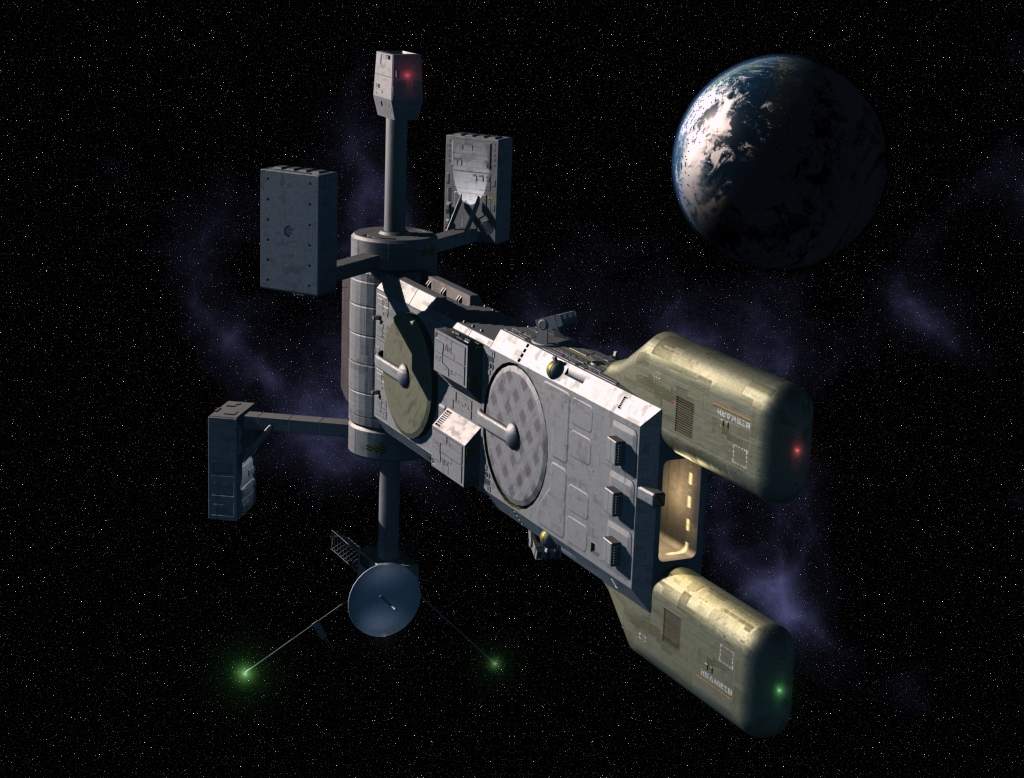
|
Above: Bismarck departing the Sol system in 2298. It has spent much of the next four years in combat on the frontier. Introduction The Bismarck and her sister-ships are pride of the Deutsches Stern Kreigsmarine (DSKM) and are amongst the most renowned human warships of the war against the Kafers. These distinctive panzersternschiffe are at the heart of the German defence strategy and the Bismarck was the first new warship laid down by Germany following the Reunification. The Bismarcks are versatile, powerful warships, capable of holding their own against the most powerful of opponents, carrying a number of screening fighter craft and embarking a battalion of marines. Acknowledgements This article is based on the Bismarck class ship described in GDW's Ships of the French Arm Sourcebook. All pictures in this article are by Laurent Esmiol. Narrative The pale, slightly unworldly Ukrainian sat hunched up in his chair on the bridge. Intently watching the tactical display, seemingly unaware of the activity elsewhere on the bridge. Kapitän Hase maintained full control of his vessel, leading the powerful human striking group around the edge of Arcturus' FTL shelf. The scarred, veteran survivors of Eta Bootis - Konstantin, Bossompierre, Hamburg, Jefferson and not least Bismarck - mongrel scrappers whose crews were now more loyal to each other than their national fleets. Expert killers of Kafers, rightly feared by the besieging aliens and heroes to the Aurorans. The man that held them together sat in the chair vacated by Kommodore Lutke, turning over command of Germany's most powerful warship to a foreigner. Not a man in the kampfgruppe queried the decision, not since the bitter days of June when the Ukrainian, a political innocent but tactical genius, saved both the fleet and Aurore. He nodded slowly as the squadron flickered in and out across the FTL shelf, failing to detect any warning pulses. At a flicker of his hand the final approach began. The squadron flashed past the stationary, skulking Australian picket which sent a final targeting package. The four Kafer warships, newly arrived in system dawdled at low readiness, unawares. The human ships had already deployed their missiles and were racing towards their targets. Sergei Sergeivich Borodin still had not said a word, but as the first strikes hit home his face split in a thin smile. Development
History With Reunification underway and war against France imminent the three starfaring German nations; Bavaria, Brandenburg and Hannover combined their forces to create a new pan-German space force, the Deutsches Stern Kriegsmarine. This wartime force was an unsteady mixture of warships from the three national forces reinforced with privateers operating under the German flag. Common operating doctrine was non existent, significant parts of the Bavarian core fleet opted for armed neutrality and the privateers were of dubious reliability and ability. Yet in spite of these problems the DSKM managed to severely hamper and harry their French opponents; disrupting trade whilst wining some notable victories on the frontier. The DSKM was maintained after the war and reformed to create a true unified service. However the greatest deficiency was the small size of the fleet in comparison to the French. In space the armed truce between France and Germany evident on the Rhine was a more fluid affair and German ships faced routine harassment. During the war DSKM command had developed, or rather redeveloped, the policy of the riskflotte. The desired a fleet strong enough that to defeat it France, or any other opponent, would risk so many casualties that her own position would be grievously weakened. To achieve this a major shipbuilding program was required which commenced as soon as the war ended. This German shipbuilding programme was hampered by the state of the new nation's space industries upon unification. Bavaria had a large merchant navy and large shipbuilding capacity but her indigenous warship production capacity was relatively small. The loss of the shipyards above Freihafen was keenly felt and although agreements were made to continue product, no warships would be built for Germany above Tirane. Germany did maintain control over the Neubayern shipyards, but was concerned about a possible French 'Copenhagen' of any large warship built there and lacked the resources to protect against such a move in the short term. Hannover and Brandenberg purchased all their warships larger than fighters from abroad. These limitations dictated that German facilities above Luna needed to be dramatically expanded. Massive investment was injected into the New Kiel orbital dock and the first elements of the Bismarck laid down as soon as the first large bay became available. In the meantime wartime emergency production of fighters and small warships continued at the available facilities. The design of the Bismarck was begun during the war and finished in September of 2293. The ship was designed with two key characteristics in mind; survivability and sustainability. Consequently the ship is well armoured and shielded, having substantial defensive and offensive firepower. In addition she carries a large complement of marines as well as her own Gustav fighter craft. This adds up to an impressively versatile warship, capable of a whole range of operations. The Bismarck was produced, where possible, from many commonly available components to ease problems of repair outside of the core systems. This decision to rely on off-the-shelf components meant that parts of the ship's systems were less than cutting edge, however the ship was completed in a then unprecedented 4 years. The production of the later Guderian and Tirpitz has been markedly slower due to the introduction of more advanced technology. |
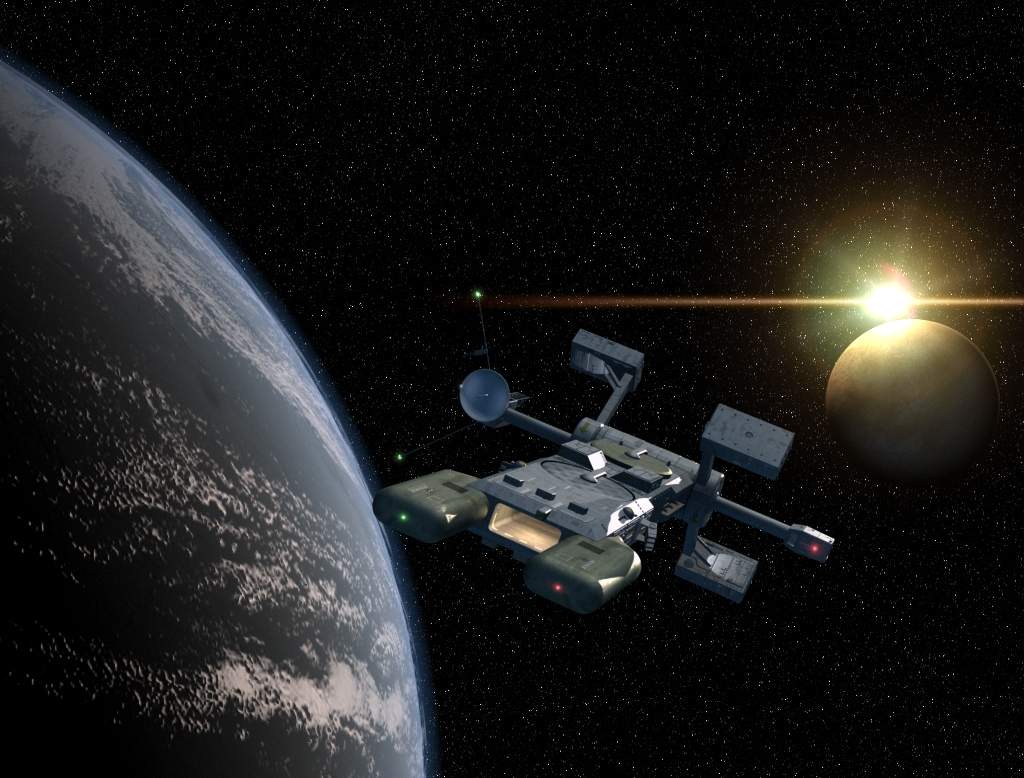
|
Above: Guderian in transit through Vogelheim on its way to join Rochemont's Fleet during 2301. During the War of Reunification Germany was mostly on the back foot, trying to hamper the efforts of the French to bring their superior power to bear. German zerstörer and privateer squadrons preyed on French merchant shipping and were in turn attacked by French Chasseur and escort units. In the colonial systems however the Germans successfully operated a system of tightly integrated battlegroups or kampfgruppe. The kampfgruppe proved difficult for the French to track and were capable of isolating and overwhelming individual warships and savaging shipping. French attempts to counter the kampfgruppe by massing their forces against them usually created opportunities for individual German units against now un-escorted merchants. The Bismarck was designed in the light of this experience, to become the centrepiece of a much more powerful kampfgruppe. She was to be able to deploy deep into the frontiers and force the French to send a large proportion of her fleet units to hunt her down. The Bismarck would use its drones and fighter screen to locate vulnerable French ships and engage them, if tracked down by superior French forces they would aim to retreat. The robustness of the German ships would increase the chances of an escape and decrease the chances of random fire disabling a ship. In general German ships are designed for stand up fights. The emphasis is on protection and firepower, and the expense of speed. German ships use missile packs almost exclusively in their designs, and have developed novel tactics for fleet actions. It is usual for the kampfgruppe to have one or more warships out ahead as an advance guard or vorausabteilung. On contact these launch all their missiles in a single volley, controlled by the ships further to the rear. This is very effective, and results in a very high damage potential, but the isolated vorausabteilung can be in a very vulnerable position. German casualties frequently come from this ship being cut off and shot to pieces outside of the support of its comrades. As a result of both the 'fleet-in-bring' nature of the kampfgruppe and the potential vulnerability of the vorausabteilung German tactics stress maintaining the fighting cohesion, or kampfzusammenhang, of the kampfgruppe during fleet actions. Indeed the fate of Kampfgruppe Hipper at the 2nd Battle of Beta Comae Berenices was blamed on Kommodore Waldermann's decision to co-operate closely with the British squadron damaging the cohesion of his Kampfgruppe. The stress placed by the DSKM on kampfzusammenhang and the need to maintain a fleet in being is often overlooked by critics of the conduct of Kampfgruppe Scheer at BCV and Kampfgruppe Bayern at Kimanjano as well as several other more minor engagements. Some of Germany's allies have complained about the defensive nature of the kampfgruppe system. In reply the DSKM points out that no-one else has performed any better against the Kafers in similar circumstances and to the relative rates of capital ship losses when compared with the French. Rather ironically considering the early activities of the DSKM, raiding of lines of communications by individual warships is not a major part of German doctrine. This is seen as a waste of warships and an activity better conducted by privateers. Large scale commerce raiding is to be conducted by detachments from the kampfgruppe and with intimate support from it. However the events of the Kafer War has resulted in German forces being used in the individual raiding role, especially the remnants of Kampfgruppe Hipper. The basic core of the Bismarck is a Terradyne 150MW fusion, built in America pre-war and originally destined for the planned Brandenburg flagship cruiser Berlin. The Guderian and Tirpitz used a German built model, accounting in part for the much longer time taken for construction (Bismarck 4 years, Guderian 6 years, Kohl 7 years). This powers a Hyde Dynamics 100MW military specification drive for the Bismarck and native German designs for her sisters. Unfortunately the drive does not provide sufficient power for all the battle systems as well and in combat the drive is slightly under-utilised. The Bismarck is above all a missile carrier, carrying 48 SR-10 missiles in 4 packs. Unfortunately she has a limited number of missile directors, two, and as a result is not capable of launching the large co-ordinated salvos shown to be the key to victory over Kafer units. It does however give her excellent sustainability in combat. The SR-10 missile has a 3x4 warhead. During the 3rd Rio Plata War heavy armour piercing weapons were first employed by Argentina. These easily smashed through Brazilian armoured hulls and for a while it was supposed that this style of heavy missile would become the standard. Consequently one of the design features of many vessels of that era was an almost complete lack of armour, accepting the superiority of missile over armour. However later combat experience showed this premise to be mostly a false one. The 'big hitter' missiles threw far fewer pulses and so had a much smaller chance of hitting vital systems or exposed externals and, despite their better armour penetration, were actually poor performers in combat. This era has given rise to vessels like the American Kennedy class fast missile cruiser. Some nations continue down the big hitter path and Germany is one. The 3x4 of the SR-10 is an excellent armour penetrator, but delivers only 30% of the firepower of the French Ritage-2. Offensive energy weapons are also based on the big hitter principle with 6 x3-2 Allen BMZ Particle Beam Weapons Systems and 8 x2+1 Allen VEW-1000 lasers in double mounts. These weapons are all built by Allen Optik of Hochbaden and are noted for their reliability and accuracy, AO having had the reputation of building the best focal arrays in Terran space. The big particle cannon are excellent weapons for engaging large starships or planetside targets but simply cannot fire rapidly enough to engage small high speed targets like missiles. The VEW-1000 are excellent dual purpose weapons, capable of engaging high speed contacts but are not optimised for defensive fire, being overly powerful for use against missiles. However they have proved good anti-fighter weapons. While good weapon systems there simply are not enough of them to protect the Bismarck, and she must travel under escort. This does not pose a particular problem under German kampfgruppe doctrine or under British Admiral Graham's system of fighting orders for the Combined Terran Forces. The Bismarckís main defences are passive. She has a thick armoured hull, the equivalent of 72cm of steel composed of the latest composite materials, and a highly advanced screen system. Together these make the Bismarck one of the best, if not the best, protected capital ship in the Terran inventory. The Fire Control system of the Bismarck is based on 6 fire control radars linked into a network of target computers. The Bismarckís weapons are capable of engaging considerably more targets than this and the FCS is the weak link in the chain, especially since the radars are part of the outerworks and not protected by the thick hull. Even Kafer units have managed to swamp her defences in the past and the Bismarckís DC teams are often busy in combat. The Sensor Suite is adequate, but not up to the expected specifications of a warship of this size. The active array is one more commonly found on destroyers, and is a reflection of just how underpowered the Bismarck really is. The short ranged passive suite is a serious worry, reflecting just how far behind in this area Germany is. The pragmatic solution would be to buy from France, Britain or America, but expediency rather than pragmatism was in the minds of the designers in 2293. Stealth characteristics are excellent however. By using highly advanced hull materials and masking the designers have brought the signature of the Bismarck down to one more akin to a cruiser than a battleship. The Bismarck is also designed as a carrier vessel. Her principle strike fighter is the old Bavarian Gustav, which was designed during the 'big hitter' era of the 2280ís. She is designed to carry between 6 and 12, but they are so scarce that far fewer are being carried. These vessels are now getting scarce and it is likely that a new fighter will be replacing them in the near future. In addition, the Bismarck is designed for force projection, and 3 large landers are carried. These are not 'assault' landers, but rather larger landers capable of moving a company of troops in one lift. These can also move an equivalent amount of cargo or heavy kit. They have a rudimentary STOL capability but require a prepared landing strip. These are the same landers used on the Ramcke class fast troopships and whilst somewhat long in the tooth are likely to soldier on for several more years before being replaced. The Deutsches Stern Marinekorps is descended from the elite pre-Reunification Bayerisches Stern Marinekorps. It has expanded in recent years to keep pace with the growth of the DSKM but whilst the original Bavarian contingent has been diluted its high standards remain. In particular its combat record against the Kafers on Aurore ranks it amongst humanities' finest. Unlike its French, British or American counterparts the DSM is committed only to the provision of troops for warships, larger scale colonial intervention forces are provided by the army's IX Korps, and detachments identify passionately with their ships. The Bismarcks can carry a 420 man DSM force known as a marine landing force, or Sternmarinelandungkraft. The SLK is an all-arms force of battalion (-) size, capable of operating in space or on land. The SLK has two Jäger Companies (Nos. 1 & 2) and a support company (No.3) as well as HQ command and logistics elements. The Jäger Companies are versatile light infantry sub-units which make up the bulk of the unit. No.3 Kompanie has 8 LkPz-VIIIs, 8 LkPzTg-Vs, 10 Kz-VII combat walkers in addition to other support weapons teams (which double as infantry) providing intimate combat support. The LkPzTg-V's provide transport for some of the dismounted Jägers when on the ground. It should be noted that restricted stowage inside the Bismarck means that loading the SLK's vehicles onto landers is a lengthy process. Sometimes only a small proportion of the SLK is actually embarked on the ship. Sternmarinelandungkraft Bismarck was formed from Sternmarineschutzen Abteilung 175, originally part of the Hochbaden Garrison. Ironically this unit was deployed on exercise, proving the SLK concept in Tanstaafl at Eta Bootis in 2298 when the Kafer's first assaulted Aurore. It formed an important keystone in the independent nation's defence and was eventually united with their new carrier when the humans liberated the system. Ever since SLK Bismarck has had an impressive reputation separate from, but complimentary to, that of the warship. It has seen repeated action on space and land in the Eta Bootis system and beyond. Indeed the success of SLK Bismarck in ground combat led to the 2300 mission to Arcturus being given to the US Marines as the German marines could not be spared. Sternmarinelandungkraft Guderian was raised directly from the DSM's depots in the Sol system and trained to a program coinciding with the launch of the ship. SLK Guderian has also mainly seen action in the Eta Bootis system, frequently on Aurore being deployed to aid the mopping up of Kafer forces following the 2302 landings. The marines of Guderian and Bismarck have excellent esprit de corps which sometime leads to inter unit rivalry. SLK Tirpitz has also been formed from Sol depots and is in the final stages of build-up training in anticipation of the Tirpitz finishing her fleet trials. |
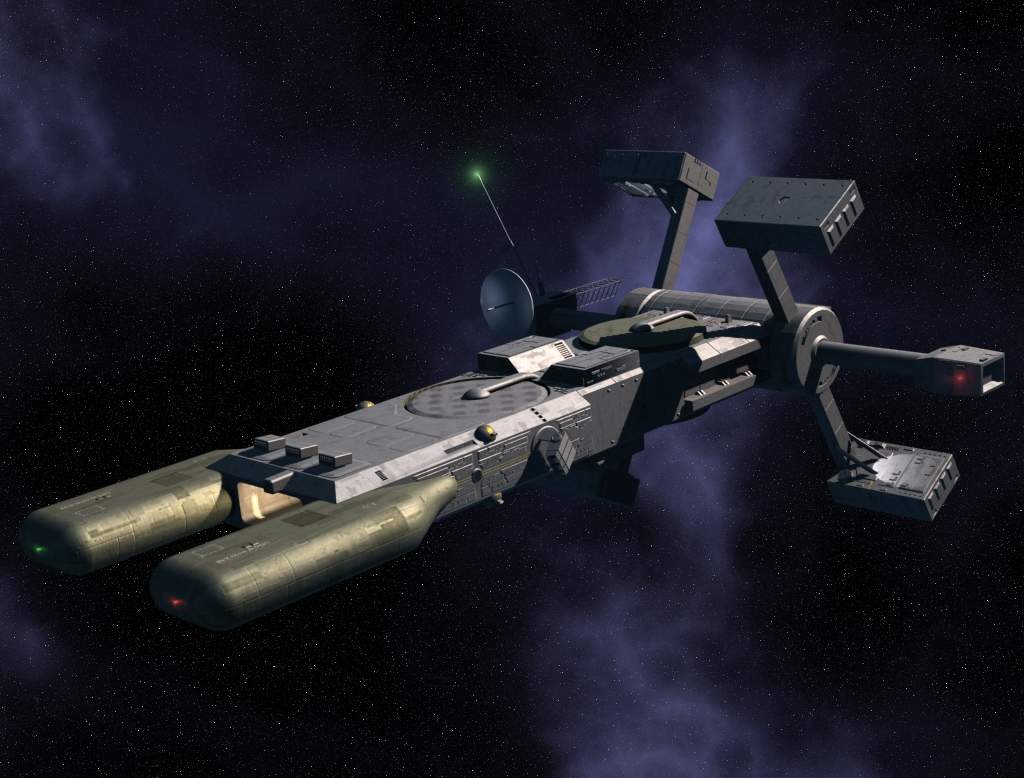
|
Above: Bismarck en route to Hochbaden 15 June 2301. The 3rd Battle of Hochbaden commenced the next day. Bismarck The Bismarck was commissioned in early 2298, and immediately sent uparm to support the German squadron at Hochbaden, arriving just in time to join in the counterattack at Aurore. Although pounded in the battle, the Bismarck managed to successfully pursue a Beta class Battleship into the rings of Laodaemon, where it was attempting to discharge its stutterwarp before it could leave the system. In a hard fought action the Bismarck achieved a victory and managed to place a boarding party on the downed battleship, unfortunately the enemy vessel was descending into the Gas Giant and control was only gained for a few hours. However the intelligence gained from this action was immense and reasonable plans for the Kafer Beta class were soon in Terran intelligence circles. The Bismarck was heavily damaged in these two fights and retired to Hochbaden for repairs and to rearm, however her fighter losses were heavy and replacements slow in arriving. The ship returned to Eta Bootis some months later and rejoined the kampfgruppe, forming part of the multi-national Aurore Fleet which quickly descended into bitter infighting. The ship served as the flagship of the kampfgruppe under the ambitious Kommodore Wilhelm Lutke, but was commanded by Kapitän Georg Hase a Bavarian gunnery specialist with much frontier experience. The ship spent most of its time in garrison at Eta Bootis but would occasionally return to Hochbaden or patrol neighbouring systems. In 2301, when the main Invasion occurred Bismarck was the second most powerful Terran vessel on the frontier. At the epic 3rd Battle of Hochbaden (16-19 June 2301) KG Bismarck was placed in reserve by the doomed French Admiral Bertrand and didn't respond in time to save the Frenchman's flagship Tallayrand from the Kafer counter-attack. However the Bismarck did effectively cover the retreat with a tightly fought rearguard action, recovering the Tallayrand's surviving Martel fighters as she did so. The Aurore Fleet, now under Borodin's command, returned to Eta Bootis in time to engage a powerful Kafer squadron in the Battle of June 23. The Bismarck provided the keystone of the human defence, which stymied the uncoordinated Kafer thrust and forced their retreat to Arcturus. The next Kafer squadron arrived only days later and was skilfully lured into ambush around Laodaemon. The massed Aurore Fleet accounted for no fewer that five Kafer ships, the Bismarck adding a Delta and Alpha to the Beta destroyed around the same world three years earlier. Coming after the debacle of 3rd Hochbaden and the loss of the Tallayrand these victories were a great boost to morale, with both Borodin and Lutke gaining laurels. The Bismarck herself began to gain a reputation as both a hard fighting and a lucky ship. Rumours of her exploits began to seep back downarm to the colonies and to earth. However this fame was bought at a price, indeed she was so badly damaged by the fighting of June 2301 that she was left behind when Borodin led his sweep into Arcturus. She remained behind as Lutke's flag, commanding the defenders of Eta Bootis which were able to force away a Kafer probe by a single battleship on the 10 July but was unable to pursue and defeat it. Soon after Bismarck's veteran troops were again committed to the surface of Aurore to help defeat a Kafer offensive. Luckily the Kafers had become wary about challenging the Aurore Fleet and aside from occasional individual raids the Eta Bootis system remained a relative sanctuary for nearly seven months. This time allowed the Bismarck to be repaired, rearmed and crew casualties replaced, often from the crews of German merchants trapped in-system. At the end of September Admiral Borodin successfully undertook a strong raid in force into the DM +18 2776 system and for the first time used the Bismarck as his flag. As 2301 drew to a close Borodin again raided Arcturus and gave out a bloody nose in the Battle of Christmas Day. Bismarck was in the thick of the action, gaining yet another battleship kill. Despite this success supplies and ordnance for the Aurore Fleet, now synonymously known as Borodin's Fleet, were running low and plans for a breakout to link with Rochemont's Fleet were being made. However in early January reinforcements finally arrived in the shape of the powerful French battleship Napoleon with Bismarck's sister ship Guderian and, most importantly, supply ships that enabled the Fleet to continue the fight. They were just in time. Borodin switched his flag to the Guderian and Lutke came back to the Bismarck. In a series of running battles from 12-15 January she helped defeat a Kafer squadron from Arcturus and led the follow-up against it, pursuing it until it broke up. Lutke then returned in time to participate in the Battle of Aurore against the Hochbaden squadron in the midst of assault operations. These battles broke the back of the Kafers in the area and the subsequent superiority of Borodin's Fleet in the border zone continually threatened Triumphant Destiny's lines of communications, contributing to its eventual defeat. The Bismarck came off relatively lightly from the January battles and was soon involved in raiding and patrolling. Her crew was by now a superb and battle-hardened team, renowned across human space with no fewer than six capital ship kills to her name. For most of 2302 she has been the centre-piece of a multi-national kampfgruppe operating in the border zone, using a mixture of pre-war DSKM tactics and procedures unique to Borodin's Fleet. She has recently been stationed at a new base in the Hochbaden system from where she took part in operations leading up to the Liberation of Dunkelheim. Crew Quality: +4 Guderian The Guderian came off the slips at New Kiel in the early summer of 2301 and was immediately despatched up the French Arm in response to the news from Aurore. Lacking a shakedown cruise she deployed with a large number of shipyard workers still on-board who helped to get the vessel fully functional during its voyage to the Beta Canum cluster. Once there the Guderian and her kampfgruppe married up with Rochemont's Fleet at Vogelheim to attempt passage to Eta Bootis. The presence of the newly arrived Guderian and Napoleon proved instrumental in repelling a Kafer follow-up after Rochemont's abortive 2nd Relief Expedition. Without these newly arrived ships Rochemont's disordered Fleet, in dire need of replenishment could have been badly mauled. Guderian played only a small role in the running battle but it proved an excellent baptism of fire for the ship. The 3rd Relief Expedition launched the next month proved more successful and the Guderian and Napoleon managed to slip through Kafer lines to reach Borodin's Fleet at Eta Bootis. On arrival the relatively inexperienced Guderian became Rear Admiral Borodin's flagship. On 12 January 2302 she found herself in the leading rank of the Aurore Fleet in a stand-up fight with a Kafer squadron helping inflict a decisive victory and sharing her first kill of a Beta. The very next day Guderian was involved in the ambush of another Kafer squadron and its pursuit, taking serious damage in the process. 15 January saw the climactic Battle of Aurore with yet another Kafer squadron being engaged and defeated in close orbit around Aurore. These three days of battle left the Guderian with severe battle damage and repairs had to be carried out. However the Kafers were badly mauled and had little stomach for further fighting. Since then the Guderian has remained with Borodin's Fleet, sometimes conducting raids into neighbouring systems. Although she lacks the glamour of her sister ship the Guderian has a well drilled and experienced crew and is well regarded in Borodin's Fleet. Crew Quality: +3 Tirpitz The final vessel of the class, Tirpitz has only recently been commissioned and is currently undertaking its fleet trials. Crew Quality: +1 |
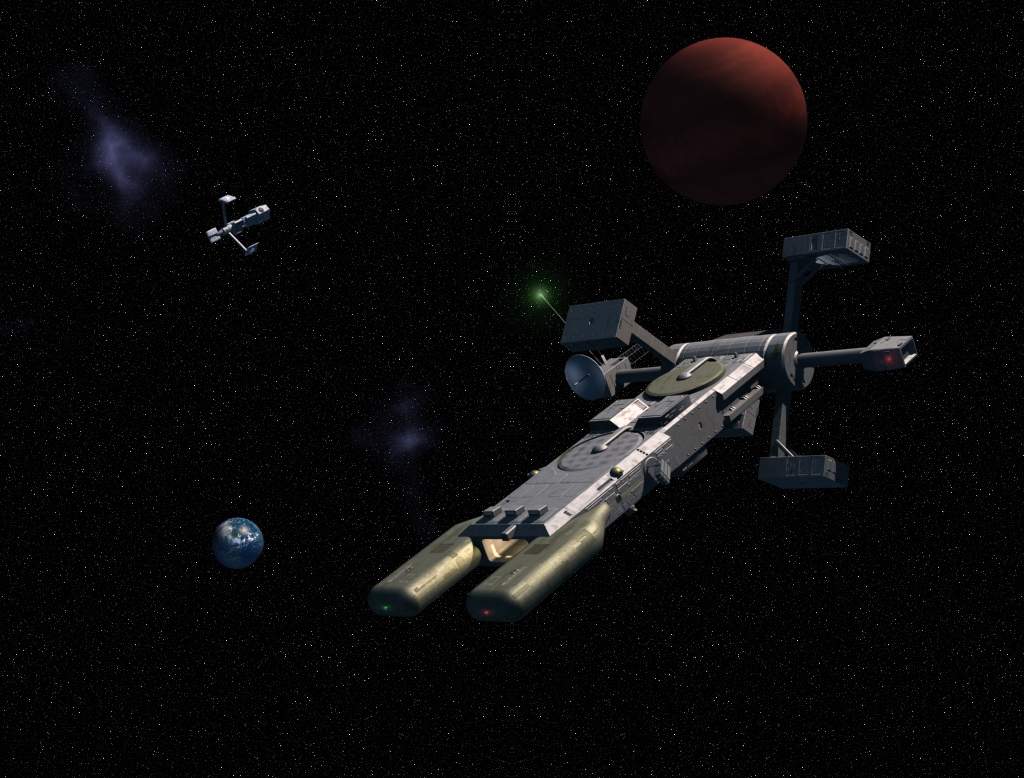
|
Above: Tirpitz conducting trials of its combat systems in conjunction with a MSIF Cruiser the Dupleix. Both French and German authorities have been making strenuous efforts to improve co-operation in the light of significant failings during the Kafer War so far. Bismarck class Battlecruiser Design Date: 2293
Performance
Power Plant: 150
MW fusion Ship Status Sheet
Hull hits: 150/75/38
Weapons Ordnance Load
Sensors and Electronics:
|
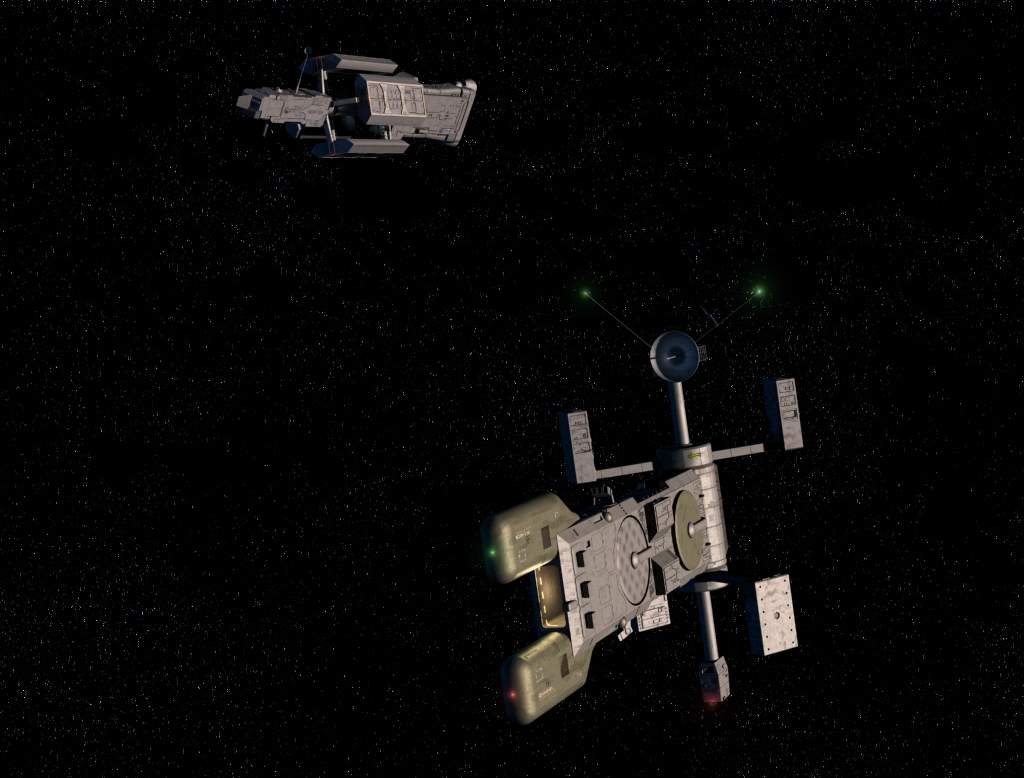
|
Above: A real example of succesful Franco-German co-operation. Guderian and Napoleon in close formation on their dramatic arrival in the Eta Bootis system January 2302. Gustav class Fighter Design Date: 2284 The Gustav was designed as a high performance interceptor for the BSM during the Central Asian War. With the generally inferior speed of their ships, Bavarian high command commissioned a fighter built entirely for speed. The concept being for centrally based Gustavs being able to strike Manchu raiders discharging in the outer system from a central base or carrier. Combined with a sentinel net this was initially extremely successful but Manchu forces took to setting off the Sentinels and ambushing the responding fighters. The Gustav has since become the main carrier based fighter of the new DSKM, its speed adding a long range punch to their battlegroups. Attacking at warp four and carrying a heavy load of submuntions, the Gustav can be devastating. The main problem is that in order to achieve such high speeds it was necessary for the fighter to be totally un-armoured. This has lead to unacceptable attrition rates and all new build Gustavs (the Gustav II) after late 2301 are well armoured, at the cost of reduced performance. Performance
Power Plant: 4MW MHD Turbine Fuel: 57.6 tons (24
hours) Passengers: none
Ship Status Sheet
Hull hits: 2/1 Weapons LHH-637 Submunition Launcher (2x4, 4 shots) Sensors and Electronics: Phased Active-7Spherical Passive-12 Navigation Radar Damage Control: 0 Design Notes This design is based on the Bismarck from Ships of the French Arm, but has been backengineered and reworked to make her 100% NAM compatible. For example, SotFA lists 27 TAC crew, but only accounts for about 14 of these. I used this as 'wiggle room' to try and beef her up a bit, without altering the essential design. The following is
a list of changes:
Data on German Marines in canon is limited mainly to brief comments in the Aurore and Invasion Sourcebook. These reveal that small numbers of marines fought well on Aurore in the initial invasion and that they are descended from the Bavarian Marines. An article on German Marines in the old 2300AD Resource exists on Kevin C's site (http://www.geocities.com/TimesSquare/Arcade/2303/kevin.htm), but Kevin and I are unsure as to its authorship. This article pins the number of marines at around 2000, which is consistent with an elite force of ship's troops. However assertions that Germany has no assault or troop ship capability seems to me to be counter-intuitive for a force of a nation with a star spanning network of colonies. The article describes the force deployed on the Bismarck as a unit of four combat companies, a lean HQ and a lot of vehicles. I've kept the concept of a versatile force with some embarked AFVs but added more slack into the structure in the shape of larger support and HQ elements. DJMH |